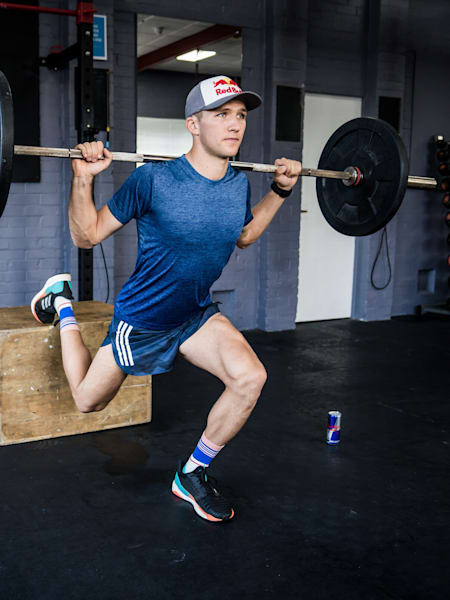Runners, get May 4, 2025, marked in your diaries because that's when the 12th edition of the Wings for Life World Run will take place all around the globe. With that record-breaking day now penciled-in, it's time to turn your attention to getting in your best possible shape and strength training can really help you smash your goals. And someone who knows more than a thing or two about conquering big aspirations is ultramarathon runner Tom Evans.
The British athlete knows the importance of building strength as a runner and below he shares some full-body exercises that boost muscle in the legs, arms and core. Runners of all abilities should see a benefit by doing them, no matter if you're aiming to complete 5k or 100k.
“Strength training can have huge benefits for runners,” says Evans. “For starters, stronger leg muscles can deliver more power when running, while strengthening connective tissues such as your tendons and ligaments can make you less prone to injury.”
Improving your upper-body strength can also boost your running efficiency. “With a stronger core, you'll be able to maintain a stable upper body, minimising side-to-side movement and better hold your form at the end of a race when you begin to tire,” adds Tom. “And by developing strength in your arms, you'll improve your arm drive so you can inject more power into your stride.”
How to do these exercises
The below workout targets the legs, arms and core. "I’d recommend starting these exercises using just your own bodyweight and progressing to using free weights as you feel yourself getting stronger," advises Tom.
“Follow the below exercises in order, taking 90 seconds’ rest between each set and two minutes’ rest before moving onto the next exercise. When following this routine, concentrate on nailing your form rather than completing the exercises as quickly as you can. Use a mirror or ask someone to check you’re doing the exercises correctly.”
Find out how you can take part in Wings for Life World Run and support spinal cord injury research.
01
Press-ups
Reps and sets: 10 reps; 2 sets
Benefits: Strengthens the chest, shoulders and arms to improve posture and arm drive while running.
● Lie face down with your hands on the floor either side of your chest. Your toes should be tucked under.
● Press down into your hands, raising your body off the floor. Keep your body straight and avoid stretching your neck.
● When your arms are almost fully extended (don’t lock your elbows), lower your body back down, almost to the floor, and repeat.
02
Dumbbell row
Reps and sets: 12 reps on each side; 2 sets
Benefits: Strengthens the upper back to balance out chest strength.
● Place your left knee and hand on a bench. Your upper body should be horizontal.
● Take a dumbbell in your right hand, arm extended towards the floor.
● Pull the weight up towards you, keeping your elbow close to your waist, then lower to the start position.
03
Tricep dips
Reps and sets: 12 reps; 2 sets
Benefits: Strengthens the arms and shoulders to help you maintain an upright running posture.
● Sit with the heel of your hands on the edge of a bench with your fingers over the edge.
● Take the weight off your body with your arms and, bending at the elbows, lower yourself down. Push back up with your arms (avoid using your legs to lift yourself) and repeat.
04
Step-ups
Reps and sets: 10 reps on each side; 2 sets
Benefits: Works all major muscle groups in the legs, improving running power.
● Stand in front of a bench or box (ensure it’s strong enough to hold your weight).
● Place one foot onto the bench and push off your rear leg to step up, keeping your body tall and your knee over your ankle on your supporting leg. Think about bringing your hips forwards and up rather than pulling forwards with your knees.
● Bring your trail leg up to a high knee position without it touching the bench. Then lower it back down to the floor.
● To increase difficulty, hold dumbbells in each hand.
05
Squats
Reps and sets: 15 reps; 2 sets
Benefits: Strengthens the major muscle groups used when running decreasing injury risk. Also improves flexibility for a faster, more efficient running stride.
● Stand with your feet a little wider than hip-width apart, toes pointing slightly outwards.
● Lower yourself down, bending at the knee and hip, as though you’re sitting down on a chair.
● Keep your knees over your ankles and your chest up. Focus on your bum going back.
● Lower down close to a sitting position, then push up through your heels and return to standing.
● To increase difficulty, hold a kettlebell at chest height while performing the movement, or rest a barbell across your upper back.
06
Walking lunges
Reps and sets: 8 reps on each side; 2 sets
Benefits: Improves single-leg balance for improved stability and coordination when you run. Also increases stride length helping you to run faster.
● Stand with your feet shoulder-width apart.
● Take a big step forward with one leg and lower your body and rear knee towards the floor, making sure it doesn't make contact.
● Keep your front knee over your ankle and your body upright.
● Push off your rear leg and step your front leg backwards to meet your rear leg.
● Repeat alternating your lead leg.
● To make this exercise more challenging, hold a dumbbell in each hand by your side (choose a weight that's suitable for you). Alternatively, to work your core more, hold a medicine ball in both hands out in front of you. As you step forward to lunge, keep your arms straight and bring the ball up above your head. Lower it down as you step back to standing.
07
Single-leg deadlift
Reps and sets: 10 reps on each side; 2 sets
Benefits: Strengthens the glutes and hamstrings to increase running power, while also improving stability for reduced risk of injury.
● Stand tall with a dumbbell or kettlebell in your right hand.
● Take your left foot off the floor and extend your left leg behind you. Bend forward at the hip, keeping your back straight and your right arm extended towards the floor.
● Keep a slight bend in your right knee, and keep your hips level.
● Bring the weight almost to the floor and your back as close to horizontal as you can, before returning to the start position and repeating on the other side.
08
Superman/back extension
Reps and sets: 10 reps; 2 sets
Benefits: Helps strengthen the middle and upper back for a more stable, upright running posture and improved running efficiency.
● Lie face down with your hands by your ears, palms facing down.
● Lift your chest and shoulders off the floor and squeeze your shoulder blades together. Keep looking at the floor to avoid stretching your neck.
● Lower to the start position and repeat.
09
Glute bridge
Reps and sets: 15 reps; 2 sets
Benefits: Targets the glutes for improved activation when you run. This will help you to keep your pelvis level and your legs, pelvis and torso aligned when you run, boosting your stability and therefore your running efficiency.
● Lie on your back with your arms by your sides and your feet flat on the floor.
● Raise your hips towards the sky to create a straight line between your knees, hips and shoulders.
● Keep your shoulders on the floor to protect your neck.
● Hold the position for two seconds before lowering slowly back down and repeating.
● To make this more challenging, hold your arms outstretched above you.
10
Leg raises
Sets and reps: 10 reps; 2 sets
Benefits: Strengthens your hip flexors which are responsible for knee lift when you run. Also works the lower abdominals for a more stable torso.
● Lie on your back with your arms by your sides.
● Bring your feet together and raise them up as close to vertical as feels comfortable.
● Lower them slowly back to an inch above the floor and repeat.
● To make easier, perform the exercise using one leg at a time.















